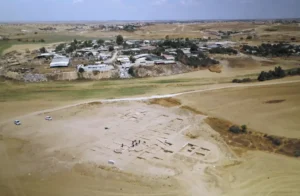Findings sheds light on the beginnings of Islam in the southern Levant as it replaced the old Byzantine rulers and Christianity.

An ancient luxurious estate and a rare rural mosque were recently discovered in the Negev Bedouin city of Rahat, shedding light on the beginnings of Islam in the southern Levant.
Over 1200 years old, the mosque is among the earliest rural mosques in the world to be excavated, the Israel Antiquities Authority said in a press release on June 22.
The excavations, directed by Oren Shmueli, Dr. Elena Kogan-Zehavi and Dr. Noe David Michael on behalf of the IAA, revealed buildings with Christian and Early Islamic characteristics in close proximity to one another.
These finds provide remarkable details of the gradual transition from Christianity to Islam that took place in the area in the seventh to ninth centuries CE, said the IAA.
The excavation, undertaken prior to the construction of a new neighborhood in Rahat and underwritten by the Authority for Development and Settlement of the Bedouin in the Negev, uncovered a Byzantine-period farmhouse which, the archaeologists believe apparently housed Christian farmers and included a fortified tower and rooms with strong walls surrounding a courtyard.
On a nearby hilltop, they found estates constructed in a completely different style, which were built about a hundred years later, in the late seventh to ninth centuries, which constitutes the Early Islamic period, said the IAA.
The estate buildings, apparently built by Muslims, were constructed with lines of rooms next to large, open courtyards. Many of the clay-lined ovens revealed in the rooms and courtyards were probably used for cooking food, according to the press release. The walls of these buildings were relatively thin and apparently supported mudbrick walls that have not survived.
In an earlier excavation in 2019 excavation led by Shahar Tzur and Dr. Jon Seligman on behalf of the IAA, another early rural mosque was excavated in the vicinity. The first of its kind to be found, the mosque provided proof of the identity of the inhabitants of the area.
Rural, 7th-century mosque
Archaeologists were surprised to discover yet another rural mosque from the seventh – eighth centuries CE in the recent, renewed excavations, said the press release.
The mosque includes a square room and a wall facing the direction of Mecca, the holy city of Islam. A niche shaped in a half-circle, is located along the center of the wall pointing southwards as is customary in a mosque. These unique architectural features indicate that the building was used as a mosque, said the archaeologists.
Set apart some 400 meters south of a luxurious estate on the hilltop site, the ancient mosque could have been used by several dozen Muslim worshippers—most likely local inhabitants—for prayers, they said.
The mosque is constructed around a central courtyard. It includes halls with stone pavement, some paved with marble, and walls decorated with frescos painted in red and yellow. Remains of fine tableware and glass vessels, some decorated with drawings of plants and animals, which were also uncovered in the building, serve as evidence to the wealth of its inhabitants, said the press release.
The combined finds of the site including dwellings, houses of prayer, ovens and utensils, shed light on the beginning of the historical process that took place in northern Negev with the introduction of Islam not only as a new religion but also as the new rulers and culture in the region, said the IAA. Islam gradually established itself in the area, taking over from the Byzantine rulers and their Christian religion which had controlled the area for hundreds of years.
The archaeological site and its finds will be integrated into the development of the city, said IAA director Eli Eskozido.
